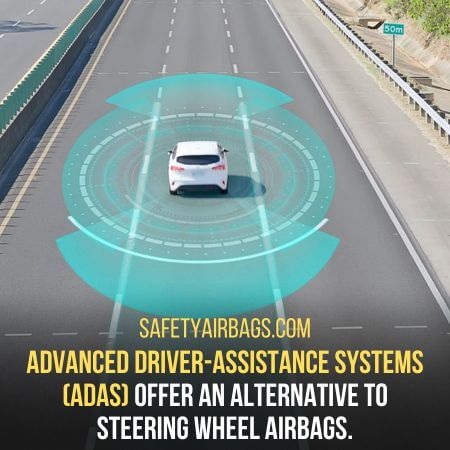Is a steering wheel without an airbag legal? The legality of a steering wheel without an airbag depends on the jurisdiction and safety regulations.
What Will I learn
- 1 Is A Steering Wheel Without An Airbag Legal? Potential Regulations
- 2 The Role of Steering Wheel Airbags in Collision Safety
- 3 Common Concerns and Misconceptions about Steering Wheel Airbags
- 4 Challenges and Limitations of Steering Wheel Airbags
- 5 Alternatives to Steering Wheel Airbags
- 6 Public Awareness and Education on Steering Wheel Airbag Safety
- 7 Conclusion:
A steering wheel airbag is a safety device installed in the steering wheel of a vehicle that deploys rapidly during a collision to protect the driver from severe impact forces.
Is A Steering Wheel Without An Airbag Legal? Potential Regulations
The legality of a steering wheel without an airbag depends on the specific regulations and requirements set forth by the governing transportation authority in your jurisdiction.
In many countries, modern vehicles must be equipped with airbags as a safety feature, particularly for the driver’s seat.
These regulations aim to enhance occupant protection in the event of a collision.
Safety standards for steering wheel airbags:
Regulatory bodies and organizations responsible for vehicle safety establish safety standards for steering wheel airbags.

These standards define the design, performance, and reliability criteria that airbags must meet to be considered safe and effective.
They cover various aspects, including deployment speed, inflation pressure, location within the steering wheel, and compatibility with other safety systems in the vehicle.
Manufacturers must adhere to these standards during the design, production, and testing of steering wheel airbags to ensure their compliance with safety requirements.
Compliance and certification processes:
Manufacturers of vehicles equipped with steering wheel airbags must demonstrate compliance with safety regulations and standards.
This typically involves rigorous testing and evaluation procedures to verify that the airbags meet the specified performance and safety criteria.
Compliance and certification processes may include various tests, such as crash tests, deployment tests, and reliability assessments.
Once a manufacturer demonstrates compliance, they receive certifications or approvals from relevant authorities.
This affirms that their steering wheel airbags meet the necessary safety requirements.
The Role of Steering Wheel Airbags in Collision Safety
Steering wheel airbags play a crucial role in collision safety by reducing the risk of head and upper body injuries for drivers.
They provide an additional layer of protection in frontal collisions, working with other safety features to enhance occupant safety and reduce the severity of injuries.
How steering wheel airbags protect the driver:
Steering wheel airbags are designed to provide a cushioning effect and act as a supplementary restraint system during a collision.
When a collision occurs, the airbag rapidly inflates, forming a protective barrier between the driver and the steering wheel.
This reduces the direct impact of the collision on the driver’s head and upper body.
Distribution of impact forces during a collision:
Steering wheel airbags help distribute the impact forces across a larger area of the driver’s body, which helps to minimize the concentrated force on specific body parts.
The risk of severe injuries, such as skull fractures or internal organ damage, is significantly reduced by spreading the forces over a broader surface.
Reducing the risk of head and chest injuries:
One of the primary functions of a steering wheel airbag is to reduce the risk of head and chest injuries during a collision.
The airbag provides a soft cushioning surface that absorbs and dissipates the energy of the impact.
It minimizes the chances of severe head trauma, concussions, and chest injuries caused by the driver striking the steering wheel.
Enhancing the effectiveness of seat belts
Steering wheel airbags work in conjunction with seat belts to enhance occupant safety.
When the airbag deploys, it prevents the driver’s head and upper body from forcefully moving forward and contacting the steering wheel.
This interaction with the airbag allows the seat belt to function more effectively by keeping the driver securely restrained.
This reduces the likelihood of being thrown forward and reduces the risk of injuries.
Common Concerns and Misconceptions about Steering Wheel Airbags
It’s important to understand that airbags are designed to work in conjunction with seat belts and other safety features.
Also, they undergo rigorous testing to ensure their effectiveness and safety.
1. Potential risks and malfunctions of steering wheel airbags:
While steering wheel airbags are designed to enhance safety, there are potential risks and malfunctions associated with their use.

These include improper deployment, non-deployment during a collision, or inadvertent deployment when there is no impact.
Manufacturers continually work to improve airbag technology and minimize these risks through rigorous testing, quality control, and safety protocols.
2. Addressing misconceptions about airbag deployment:
There are several misconceptions surrounding airbag deployment, such as the belief that they will deploy in every collision regardless of the severity.
In reality, airbags are designed to deploy in moderate to severe collisions that meet specific criteria.
To have realistic expectations about their functionality, it is important to understand the factors influencing airbag deployment, including impact speed, angle, and direction.
3. Importance of proper installation and maintenance:
Proper installation and maintenance of steering wheel airbags are crucial for their effective performance.
Incorrect installation or airbag system tampering can compromise functionality and pose safety risks.
Regular maintenance and inspections ensure the airbags are in good working condition and respond appropriately during a collision.
Vehicle owners should follow manufacturer guidelines and seek professional assistance for installing, repairing, and maintaining steering wheel airbags.
Challenges and Limitations of Steering Wheel Airbags
Challenges and limitations of steering wheel airbags include the potential for injury to occupants with certain body positions or near the airbag deployment zone.
Also, steering wheel airbags may not protect against certain collisions, such as side impacts or rollovers.
This highlights the importance of a comprehensive safety system in vehicles.
1. Compatibility issues with aftermarket steering wheel modifications:
One of the challenges associated with steering wheel airbags is compatibility with aftermarket modifications.
Modifying the steering wheel, such as installing non-standard components or accessories, can potentially impact the proper deployment and functionality of the airbag system.
It is essential to ensure that any modifications to the steering wheel are compatible with the original airbag system to maintain its effectiveness.
2. Cost considerations for replacing or repairing steering wheel airbags:
Replacing or repairing a steering wheel airbag can be costly in the event of a deployment or malfunction.
Airbag systems are intricate and require specialized knowledge and equipment for installation and repairs.
Additionally, the cost of genuine airbag components and labor can be significant.
Vehicle owners should consider the financial implications and factor in the cost of maintaining and replacing steering wheel airbags when necessary.
Alternatives to Steering Wheel Airbags
Alternatives to steering wheel airbags include advanced driver-assistance systems (ADAS) that offer active safety features.
These include collision warnings and automatic emergency braking. Here are details about that:
1. advanced driver-assistance systems (ADAS) as a supplement to airbags:
Advanced driver-assistance systems (ADAS) offer an alternative to steering wheel airbags by providing active safety features that can help prevent accidents or mitigate their severity.\

ADAS technologies include:
– Collision warning systems
– Lane departure warnings,
– Adaptive cruise control
– Automatic emergency braking.
These systems work with airbags to provide a comprehensive safety package for drivers and occupants.
2. Integration of additional safety features in vehicles:
Vehicle manufacturers continuously integrate additional safety features into vehicles to enhance occupant protection.
These features may include:
– Side curtain airbags
– Knee airbags
– Advanced seat belt systems
– Reinforced vehicle structures, and
– Improved crash avoidance technologies.
The goal is to create a multi-layered safety approach beyond steering wheel airbags to provide enhanced protection in different collision scenarios.
Public Awareness and Education on Steering Wheel Airbag Safety
Public awareness and education on steering wheel airbag safety are crucial in promoting proper usage and understanding their benefits and limitations.
Informative campaigns, safety guidelines, and vehicle user manuals can help raise awareness.
This awareness includes the importance of airbags, proper seating positions, and the need for comprehensive safety measures in vehicles.
Importance of educating drivers about the benefits of steering wheel airbags:
Educating drivers about the benefits of steering wheel airbags is crucial for promoting vehicle safety.

Many drivers may not fully understand the role and significance of airbags in protecting them during collisions.
By providing information on how airbags work, drivers can make more informed decisions and prioritize their safety and passengers’ safety.
Collaboration between manufacturers, government agencies, and safety organizations:
Collaboration between manufacturers, government agencies, and safety organizations is essential to raise public awareness about steering wheel airbag safety.
These stakeholders can work together to develop educational campaigns, safety guidelines, and initiatives.
They can highlight the importance of steering wheel airbags and promote their proper use.
Promoting safe driving habits and responsible vehicle ownership:
In addition to educating drivers about steering wheel airbags, promoting safe driving habits and responsible vehicle ownership is crucial for overall road safety.
Emphasethe importance of wearing seat belts, following traffic laws, avoiding distractions and practicing defensive driving techniques.
It can complement the protective capabilities of steering wheel airbags.
Conclusion:
The legality of a steering wheel without an airbag depends on the specific regulations and requirements set by the jurisdiction where the vehicle is being operated.
In many countries, regulations mandate the installation of airbags as a safety feature in vehicles.
These regulations are in place to enhance occupant protection and reduce the risk of injuries during collisions.
Steering wheel airbags play a vital role in vehicle safety by protecting drivers during collisions.
They help distribute impact forces, reduce the risk of head and chest injuries, and work with seat belts to enhance occupant safety.
Steering wheel airbags are important for vehicle safety and are subject to legal requirements in many countries.
Compliance with these regulations ensures that vehicles have functioning airbags to protect drivers in a collision.
